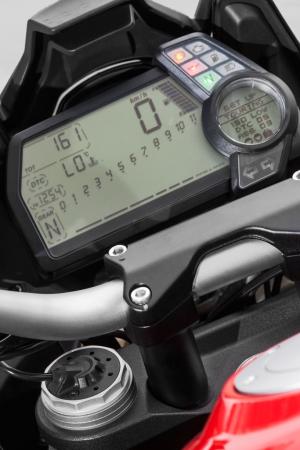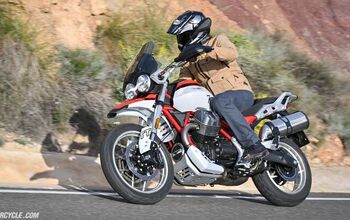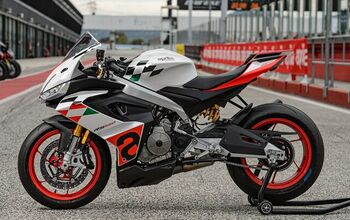2013 Ducati Multistrada 1200 S Touring Review - Motorcycle.com
Ducati broke open a niche in the adventure-touring market when it introduced the 2010 Multistrada, adopting the rugged appeal of the class but without much of the implied dirtbike-ness of the segment-leading BMW R1200GS. Despite being plopped into the A-T category, the MTS became the Italian brand’s de facto sport-touring bike.
More than 20,000 Multistradas have been sold over just 30 months, which is a sizeable number for a company that sells only 40,000 bikes a year. And of the various MTS models, it’s the travel-oriented S Touring version that sells best.
And of critical importance to Ducati’s long-term solvency is that the MTS is the first Ducati for about 80% of its owners. It is greatly expanding the appeal of what Ducati means to consumers.
“There are a lot of riders out there who are Ducati-curious,” said David James, Ducati’s international press manager, during the Multi’s 2010 launch, adding they may have previously been intimidated by Ducati’s hard-edged reputation.
The above is important to understanding why the long-legged Duc has been given an overhaul after less than three years on the market. The list of items new or retooled is extensive: cylinder heads, windshield, fairing, suspension, wheels, traction control and ABS. Ducati says the goal of the 2013 model is to further develop the bike’s touring ability without compromising its four-motorcycles-in-one concept.
Two new features on the 2013 Multi fight for the spotlight: a revised engine and a semi-active suspension. Since the “Skyhook” suspension is available only on upmarket S-class Multis and the motor mods apply to all Multistradas, we’ll begin in the engine room.
Ducati did an amazing job converting its 1198cc superbike V-Twin into a much more streetable mill for use in the MTS and, later, the Diavel. Its key modification was reducing valve overlap from the hi-po superbike’s 41 degrees to just 11 degrees, hence its “Testastretta 11°” nomenclature. However, fueling at low revs was a mite lumpy, especially in Sport mode, so Ducati engineers made three key changes to create the new “Testastretta 11° DS.”
The “DS” indicates dual spark, which features a second spark plug placed to the side of the cylinder head for more complete combustion. Further to that end is a secondary air system that pipes fresh air from the airbox through a reed valve in the cylinder heads. This enables the ECU to deliver a richer mixture at low loads and revs while still meeting emissions regs, making reapplication of throttle less lurchy. In addition, the fuel injectors are now aimed to spritz petrol directly at the inlet valves instead of at the wall of the intake duct, and this greatly aids fuel atomization rather than forming hard-to-digest droplets.
The result of these tweaks is a 5% boost in peak torque to 91.8 ft-lb, and a Ducati-supplied dyno chart shows a slight bump in power across nearly the entirety of its pull. Ducati also claims a 10% increase in fuel economy at 55 mph.
More importantly, the DS now responds much cleaner at low revs, aiding rider confidence while expanding the usable range of its powerband. Horsepower remains at a claimed 150 crankshaft horsies (or about 132 hp at the wheel). Power delivery and output is varied via four riding modes (Sport, Touring, Urban and Enduro).
The base Multistrada retails for the same $16,995 it did in 2012, and it now includes the addition of LED low-beam headlights that combine with the existing LED position lights, both of which remain lit when the incandescent high beams are switched on for maximum visibility.
Also new is the front fairing and a higher and wider windscreen that now features a clever pinch-and-slide adjustment instead of the previous two-knob arrangement, enabling on-the-fly tuning over its identical 60mm vertical range. The storage bin on right side of the cockpit gets enlarged, and its new wheels are similar to the Panigale’s. A dual-rate shock spring replaces a single-rate spiral for greater bottoming resistance.
The standard ABS system is now governed by the Bosch 9ME ECU as used in the Panigale, employing four pressure sensors (both master cylinders and front and rear calipers). The Brembo brakes are linked front to rear, with less linkage in the Sport and Enduro modes. Rear-lift detection is switched off in Sport and Enduro modes (stoppies, anyone…?). The rear tire can be skidded in Enduro, and ABS can be disabled in any mode. Any electronic setting can be manually altered and stored in memory simply by switching off the ignition.
Upgrading to the S Touring version ($19,995) gets several important additions, including removable and lockable saddlebags, a centerstand and heated grips. But most interesting is the Skyhook semi-active suspension that replaces ordinary but fully adjustable suspenders on the base version.
Ducati Skyhook Suspension (DSS) is a high-tech suspension system similar to BMW’s new HP4 using Sachs electronic solenoid valves in the left fork leg and the shock to actively alter damping circuits depending on inputs such as road speed, brake application and four accelerometers placed around the bike. The vertical accelerometers on the lower triple clamp and rear subframe transmit “sprung” data, while sensors on a lower fork leg and the swingarm provide unsprung info.
Ducati invented the Skyhook name for an imaginary fixed reference point above the bike acting like a hook in the sky. That sounds like the product of marketing men, but a more apt description is comparing DSS to an autofocus camera versus a manual one, as each riding mode has settings appropriate for each of the four-bikes-in-one riding modes. Or, like another famous marketer once said, “Just set it and forget it!”
Rear preload is four-position adjustable at the push of a button, as on the previous Ohlins DES system, to suit varying loads. Front preload must be adjusted manually from atop the right fork tube.
The Proof Is In the Ride Pudding
To test out the new MTS, Ducati invited us to sample the S Touring model in the hills and picturesque coastline surrounding Bilbao, Spain.
Sidling up to the row of Multis, not much seems new except for the “matte chrome” paint finish that appears both classy and sporty. Hidden saddlebag mounts ensure a clean tail end when not using the bags, and the new wheels look cool, especially the right-side rear that is exposed by the single-sided swingarm.
First impressions are of a very narrow waist, especially for a sport-touring-esque rig. The first bike I rode was fitted with an optional low seat that makes 6.7 inches of suspension travel 1-inch easier to manage for short legs than the stock seat placed 33.5 inches high. The low version is standard in Asian markets and is a good choice for shorter riders, but larger pilots might find the rear section tilts upward uncomfortably.
Scrolling through the ride modes and DTC settings is initially frustrating, as the system (controlled by switches on the left handlebar) isn’t particularly intuitive. That said, any owner will be able to figure them out after some miles in the saddle.
It didn’t take traveling more than a few feet to notice the revised engine’s user-friendlier power delivery at low revs. The 90-degree V-Twin now pulls cleanly from as low as 2500 rpm, making urban crawling much more pleasant. At 494 pounds wet, the Multistrada is a relative lightweight in the sport-touring ranks, and its wide handlebar and sporty steering geometry enables quick reactions to scythe up traffic or a twisty road.
The efficacy of the Multi’s new windscreen was put to the test on a freeway section. It’s now 18mm taller, which helps deflect some wind over a rider’s body, but it’s the 43mm of extra width that notably improves airflow deflection, even if not to the barn-door levels of some sport-tourers.
More impressive is the brilliantly simple windscreen adjuster that can be operated with just one hand while riding. Greater wind protection is available with the screen in its uppermost position, but I enjoyed the non-turbulent air deflected when at the screen’s lowest position. Long-haul comfort is good, with an ergonomically satisfying rider layout that puts zero strain on wrists and provides generous legroom. Tall riders might find the seat to be a bit short front to rear, which reduces butt-position options.
Bilbao was drenched with rain the night before our ride, and the roads remained damp during the morning portion of our ride. This gave a good test for the Ducati Safety Pack, which really aided rider confidence on the unfamiliar wet roads. In Touring mode, DTC’s default setting is level 5, and it makes throttle reapplication in a corner stress-free.
Also aiding rider confidence is the engine’s newfound smooth response at the low end of the bar-graph tachometer. With the old bike, I’d be feathering the clutch to tame its lumpy low-end reaction on damp surfaces. This added bottom-end smoothness also significantly widens the engine’s powerband, allowing it to pull cleanly out of tight corners even in second gear. On that subject, the Multi’s gearbox isn’t what you could call slick, although the bikes had less than 400 miles and not once was a shift missed.
Once in the twisty sections of our ride, I switched to Sport mode and noticed sharper yet still quite manageable delivery of power from the V-Twin. The extra punch in the upper midrange enabled second-gear wheelies anytime they were asked for. Pirelli Scorpion Trail tires, with a dual-compound 190/55 on the rear, offer solid grip and the open tread-block pattern that enables light off-roading.
I was so tuned in to the revised motor and new windshield that I had almost forgotten about the Skyhook suspension. Then I realized that it had offered a plush ride on the highway, yet it also delivered superbly controlled suspension when ridden like a sportbike. Previous Multistradas, and indeed almost any long-travel bike, suffered a considerable amount of front-end dive when on the brakes, but Skyhook does an amazing job of limiting longitudinal forces that can make A-T bikes squirrely during hard deceleration. Automatically tightening up the front compression and rear rebound damping when braking kept the Multi amazingly stable, especially in Sport mode.
Speaking of brakes, the Brembo/Bosch combo is as good as it gets in this category. Radial-mount two-piece calipers up front deliver strong power without feeling too touchy – perfect for a streetbike. And no need to fear the linking effect when grabbing the front lever, as its influence on the rear binder is basically imperceptible.
Almost lost in the DS and Skyhook spotlight are the amazingly bright LED headlights underscored by the LED position lamps which are nearly impossible to miss when pointed in your direction. Same for the LED signals in the handguards.
Conclusion
We already were big fans of Ducati’s liquid-cooled Multistrada, and the changes for 2013 significantly ups its appeal as both a sportbike and a touring sled. The semi-active suspension is a real advancement that will soon spread to many other motorcycles, and the smooth responsiveness of the new DS engine eliminates the biggest concern we had with the previous bike. So good is this new bike that I’d feel disappointed if I had recently purchased a 2012 MTS.
Negatives are few and far between. The centerstand tang interferes with your left heel when riding on the balls of feet, and the short sidestand causes the bike to lean far over when parked. The package could be improved by the addition of TFT instrumentation and cruise control, but these are minor annoyances rather than deal breakers.
In our Best of 2010 Awards, we observed the Multistrada “has the best combination of sport, touring and commuting that we’ve ever experienced, potentially paring down a three-bike garage to just two wheels.”
The above statement holds even more water with the introduction of the 2013 Multistrada. The only impediment to your consideration might be the $17K entry price. The updated ’Stradas will be available in North America early in 2013.
More by Kevin Duke









































Comments
Join the conversation